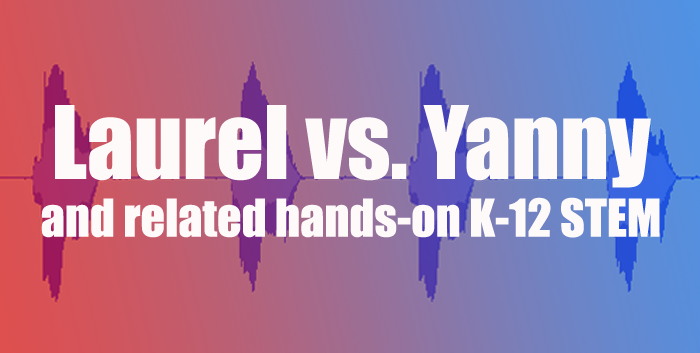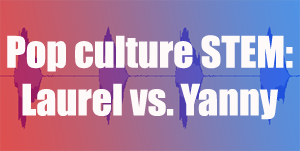Laurel vs. Yanny and Student STEM
A vocabulary site pronunciation clip turned the Internet on its ear last week when people couldn't agree on what they were hearing. Students interested in the Laurel vs. Yanny debate can explore other fascinating hands-on STEM projects related to illusion and human perception.

Is the dress blue and black or white and gold? Do you hear "Laurel" or "Yanny"? The Internet loves these kinds of brain teasers, ordinary media moments that unexpectedly divide the population into groups of people who see or hear one thing and those who see or hear something else. And in the way these things go, people often believe 100% that they see or hear what they see or hear and can't understand how anyone can see or hear something different, until, maybe, they see or hear the object in question differently themselves. That our own perception can change and can even shift back and forth is part of what makes these puzzles so fascinating. That there can be such ambiguity and divergence over something that seemingly should have a concrete and clear answer (e.g., the word is "Laurel") boggles the mind. These brain teasers send the public scrambling to find out what others see or hear and send scientists digging to unpack the science that accounts for the phenomenon.
From Visual Illusion to Audio Confusion
Whether the viral phenomenon is related to seeing or to hearing, people enjoy things that challenge the senses and make them question what they see or hear. The "dress" meme was more than three years ago, and yet most people still clearly remember the controversy over the color of the dress in a photo circulated online. In the case of the "Laurel" sound clip from a vocabulary pronunciation site, some people hear "Laurel," some hear "Yanny," some hear both, and some hear something different, depending on the device they use. Some people, in fact, report hearing something different at different times on the same device.
After teens initially circulated the confusing audio clip via social media, the Laurel vs. Yanny debate spread last week, and scientists were quick to pose hypotheses that might explain the cause of the phenomenon. One popular explanation is that when played through different speakers, ambiguous sound patterns on the original audio file sound different. The New York Times set up an interactive tool that lets listeners adjust the frequency of the clip to see how a listener perceives the word as the pitch increases or decreases. For people who stridently exclaimed, "how can anyone hear Yanny" (or vice versa), the tool helps demonstrate that the file may, indeed, sound differently based on how the sound is played and/or on what device you use to listen. Try it with earbuds or headphones and compare what you hear to your phone's speakers. Try it on your computer. Any difference?
While the postulation that frequency and some ambiguity in the sound spectrum of the clip itself may seem to explain the phenomenon, it may not be enough to completely explain Laurel vs. Yanny. Many people reported hearing something different than someone else heard while listening at the same time and through the same device. With accounts like that of the reporter who authored this article for Slate, the Laurel vs. Yanny debate can't simply be dismissed as related solely to frequency or to playback devices. There appears to be some element of individual human hearing involved in what you hear from the clip in question.
In its coverage of Laurel vs. Yanny, The Verge compared the sound clip as an audio equivalent to the visual illusion called Rubin's Vase, an image that contains more than one set of visual information. Other hypotheses focus on the age of the listener or differences from person to person in the human auditory system. These explanations may not be able to fully account for why your listening experience may change, however. If you are someone that heard Yanny one time and then heard Laurel the next time you listened, even on the same device, Laurel vs. Yanny can be especially perplexing. (The "brainstorm"/"green needle" example posted at Twitter is another example of how your perception of a sound clip can change.)
So far, there is no definitive explanation for Laurel vs. Yanny, and the case may never be completely solved because the combined listening and perception experience depends upon so many variables. For now, Laurel vs. Yanny poses an interesting social phenomenon, one that bridges age, gender, and location and emerges as an interesting tidbit for schoolyard and office debate. Laurel vs. Yanny is simply a few seconds of audio fun, one that reminds us that we can't always know exactly what someone else sees, hears, tastes, or smells. The question philosophers have often posed comes to mind: "How do I know that what I see as blue is also what you see as blue?"
Making STEM Connections
Exploring phenomena like the Stroop Effect (when your brain says the color it sees regardless of what color is written) and the McGurk Effect (when what you hear is influenced by what you see) or visual illusions can make for exciting independent or classroom science. When introducing these topics to students, pop culture may be the golden ticket to sparking student interest. Older students, especially, are often highly attuned to the world of online memes. Talking first about "the dress" or "the Laurel vs. Yanny" debate can make a great way to start talking about the human brain, perception, and the senses.
Students interested in brain teasers, mind puzzle, illusions, and ways that the brain can be accidentally or deliberately tricked into thinking it sees, hears, or even knows something other than what is really there may enjoy science activities and explorations like these:
- Apparent Motion & Animation
- Get the Scoop on Stroop
- What Conflicting Mental Tasks Reveal About Thinking: The Stroop Effect
- Do You Hear What You See?
- Are Your Eyes Playing Tricks on You? Discover the Science Behind Afterimages!
- Battle of the Senses: Taste Versus Smell
- Now You See It, Now You Don't: A Chromatic Adaptation Project
- Now You See It, Now You Don't: Investigating Inattentional Blindness
See also:
- Putting the McGurk Effect to the Test
- Seeing Is (Not Always) Believing!
- Visual Illusions: When What You See Is... Not What's There?
- Putting the McGurk Effect to the Test
Categories:
You Might Also Enjoy These Related Posts:
- Plastics and Earth Day - Science Projects
- Arduino Science Projects and Physical Computing
- 10+ Robotics Projects with the BlueBot Kit
- 5 STEM Activities with Marshmallow Peeps
- March Madness Basketball Science Projects: Sports Science Experiments
- Women in STEM! More than 60 Scientists and Engineers for Women's History Month
- Explore Artificial Intelligence and Machine Learning with Student AI Projects
- 10 Reasons to Do the Rubber Band Car Engineering Challenge










